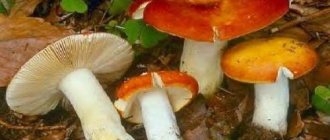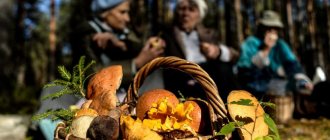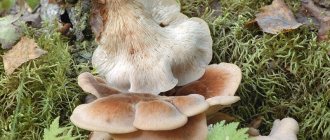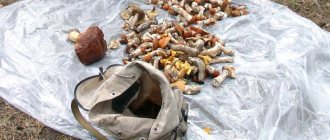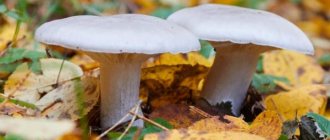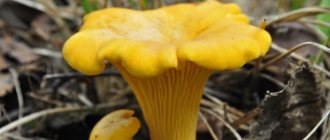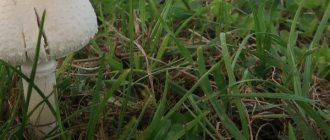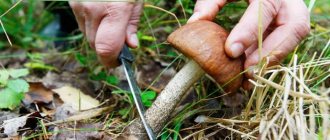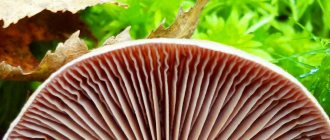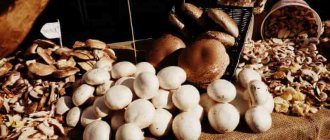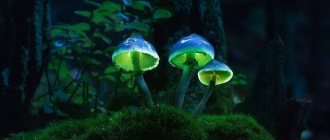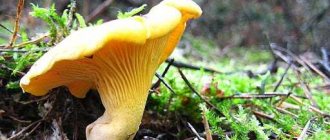The moderate continental climate in the Republic of Belarus, a large number of forests, warm and humid summers create favorable conditions for the growth of mushrooms. Some of them are unsuitable for consumption or are poisonous. The directory “Edible Mushrooms of Belarus” contains about 200 varieties. Despite the fact that this generous gift of nature has an excellent taste and many beneficial properties, it should be collected with extreme caution.
The first spring mushrooms in the forests of Belarus
The spring mushroom picking season begins quite early. As soon as the leaves appear on the birch tree, that is, already in April or May, it is quite possible to go on a quiet hunt. The most common spring mushrooms are morels and strings called “smarzhki”.
Ordinary stitch
It has a wrinkled and hollow cap with winding folds. Coloration can vary from light brown to dark brownish brown. In the last ten days of March and early April, the fruiting bodies of this variety smell of melted snow or spring streams, but a little later, around May, the mushroom aroma becomes more pronounced and very pleasant. The leg is white or cream-colored, wrinkled and hollow, shortened.
The line is gigantic
Most often found in deciduous forests. Characterized by a larger, lighter beige or slightly beige-yellowish color, less folded cap. The stem of this variety is also shortened, without a pronounced mushroom aroma and taste. Used for preparing mushroom powders, as well as preparing first and second courses, snacks.
Common morel
It has an irregularly reticulated, ovoid or spherical, hollow cap, the edges of which adhere to a yellowish or gray-brown stem. The mushroom pulp is quite thin and tender, fragile, whitish in color, with a weak aroma. The leg is hollow, cylindrical, whitish or brownish in color, with a powdery coating. It is found on old fire pits and in garden and park areas.
Morel cap
It has a thimble-shaped hat, put on a fairly high leg and attached to it at the very top. The surface is longitudinally wrinkled, yellowish-brown on the outside and whitish on the inside, without a pronounced aroma or taste. The hollow stem is white, waxy, cylindrical in shape, slightly widening at the base. No pre-boiling is used for preparation.
Mushroom picker calendar
The first mushrooms, morels and strings, appear in April, followed by, around May, the active growth of meadow champignons, oyster mushrooms, May row, puffballs and oak mushrooms begins. Towards mid-June, the first “noble” mushrooms appear in the forests. Depending on weather conditions, sometimes until December you can collect greens and greens. However, the peak mushroom season occurs from mid-July to the first ten days of October.
| Period | Peculiarities | Main edible species |
| In April-May | Spring mushrooms - “snowdrops” | Stitches and morels |
| Second half of May | Real boletus, gray russula, green flywheel, first porcini mushrooms | |
| June-early July | Spike mushrooms | Boletus and porcini mushrooms, fly mushrooms, valui, colored russula |
| Second half of summer | Champignons, redheads, summer honey mushrooms, boletus, porcini mushrooms, boletus, russula | |
| Late summer - early autumn. | Deciduous mushrooms | Saffron mushrooms, porcini mushrooms, boletuses, boletus mushrooms, chanterelles, sow mushrooms, red mushrooms, milk mushrooms, autumn honey mushrooms |
Where to collect chanterelles in Belarus (video)
We also recommend reading:
Why milk mushrooms are useful and dangerous for the human body Time and rules for collecting milk mushrooms and other edible mushrooms Technology and secrets of growing champignons at home The most mushroom places in Volgograd and other regions of Russia
Names and descriptions of summer mushrooms in Belarus
Comfortable soil and climatic conditions are favorable for the growth and development of many types of edible mushrooms, which, according to their nutritional value, belong to different categories.
White mushroom or boletus
One of the most valuable tubular varieties with a cap having a smooth or slightly wrinkled surface. Young specimens have a convex cap, but as they grow it becomes flatter. The color is light brown, brown or burgundy brown. The pulp is strong and juicy, whitish in color, with a very characteristic mushroom aroma. The legs are quite powerful, cylindrical in shape, with a light beige-brown mesh surface.
Boletus
The cap of the variety is velvety, reddish-orange, relatively large in size, initially convex in shape and slightly straightens as the fungus grows and develops. Young specimens are characterized by density and sufficient elasticity of the pulp, but over time the fruiting body begins to gradually soften. When cut, the boletus pulp quickly turns blue or black , and the pronounced aroma is almost completely absent. The stem of the mushroom is hard, with a grayish-white surface, covered with fibrous whitish or slightly brown scales.
Chanterelles
The cap and leg of the chanterelle form a single fruiting body, the color of which can vary from light yellow to yellowish-orange. This is the most popular variety in Belarus. The cap is smooth, slightly depressed or funnel-shaped, with slightly wavy edges. The pulp is elastic, whitish in color, with an unexpressed fruity odor. The leg has a fibrous type of pulp.
Map of mushroom places
The map of places in Belarus where you can collect a large number of mushrooms is very extensive. The most popular are Minsk and Vitebsk regions.
village areas, Logoisk, Pleshchenitsy, Molodi, Oleshniki, Krokva, Pogrebishche: these places are famous for the fact that porcini mushrooms, boletus, honey mushrooms, moss mushrooms, and russula are collected here throughout the summer.
Khatyn Forest near the tourist complex “Vysoky Bereg”: a huge number of people come here every year, because Elite species for mushroom pickers are abundant here. Boletus mushrooms, saffron milk caps, chanterelles and boletus mushrooms are collected there. A large number of mushroom glades are located in the village of Ilya.
The gifts of the forest can be easily found in coniferous, mixed and deciduous forests, birch groves located on the territory of the Belarusian Republic.
Autumn types of mushrooms in Belarus
During the long autumn period with warm and fairly humid weather, a second wave of growth of edible varieties is often observed.
Honey mushrooms
The variety is characterized by yellowish-brown caps of medium size. Young specimens have bell-shaped caps, which may become prostrate over time. The tall, thin, elastic leg has a film-type ring characteristic of the species, which separates and sags during the growth and development of the fruiting body.
Mosswort
An edible tubular species from the Boletaceae family. It is distinguished by a dry, slightly velvety, sometimes sticky, cracked cap. The pulp is whitish, yellowish or reddish in color, sometimes turning blue when cut. Leg with a smooth or wrinkled surface. Spore powder is brownish in color.
Poisonous mushrooms of Belarus
Not only edible varieties grow abundantly on the territory of the republic, but also a large number of poisonous and deadly species, especially for children and people with poor health.
Death cap
The most dangerous poisonous lamellar species, capable of causing fatal poisoning. Caps with a gray or olive surface, convex or prostrate, with white flesh that is tasteless and odorless. The leg is white, cylindrical, with a characteristic thickening at the base.
False foam
The cap of the mushroom is medium in size, bell-shaped in young specimens, and almost flat in adult, old mushrooms. The main color is reddish-yellow or yellowish-orange, with a darker central part. The stalk is thin and hollow, with a fibrous structure. The ring on the stem is missing, and the yellowish flesh has a bitter taste and unpleasant odor.
Fly agaric red
The fly agaric is easily recognizable thanks to its glossy, bright red cap covered with white dots. Young specimens have a hemispherical cap shape, which becomes concave over time. The stem is cylindrical, white or yellowish in color, with a tuberous thickening at the base.
Thin pig
For a long time, the variety belonged to the category of conditionally edible, but today it is a poisonous mushroom. The cap is fleshy, slightly convex in shape with rolled felt edges, or flat and funnel-shaped. The edges may be drooping, frilled, or straight ribbed, often wavy. In young specimens the surface is olive-brown or olive-brown, while in adults it is grayish-brown or rusty-brown. The flesh darkens when cut. The leg is solid, shortened, matte, smooth, ocher-olive or dirty yellow in color.
Precautionary measures
Although mushrooms contain many beneficial organic compounds and trace elements, you need to be extremely careful when consuming them. Even experienced mushroom pickers need to follow some rules.
- Do not collect old mushrooms, they can be receptacles of toxic substances, especially if they grew in environmentally unfavorable areas (along highways, near landfills and trash bins, in the industrial zone of various enterprises). Remember that the safest are boletus and chanterelles. The main determinant of the health of a mushroom is the integrity of the fruiting body (this does not mean worminess).
- There are varieties of inedible mushrooms that are very similar in appearance to representatives of edible species. Their “camouflage” is so good that many inexperienced mushroom pickers mistake them for good ones. False boletus, boletus and moss mushrooms grow in Belarusian forests. The pink film (hymenophore) under the cap helps to distinguish a “fake”.
- In some cases, poisoning occurs after eating edible mushrooms. The reason is their improper preparation. The mushrooms must be carefully examined, washed thoroughly under running water, boiled in lightly salted liquid, and only then subjected to final heat treatment.
- Please note that mushrooms need to be cooked immediately after returning home. Don't leave this matter until the next day. Within a day, they form toxins dangerous to human health.
- Not all people can eat mushrooms. It is better not to use them as food for patients with gastrointestinal problems, kidney failure, small children, pregnant and lactating women.
Symptoms of poisoning appear very quickly. If they occur, seek medical help immediately.
Belarus is famous for its large number of mushrooms. The climatic conditions of the area (humidity and alkaline soil composition) are ideal for the propagation of many varieties that humans can eat.
But mushroom pickers should be careful and extremely attentive so as not to put poisonous specimens in the basket.
Hallucinogenic mushrooms of Belarus
Just a few years ago, it was generally accepted that hallucinogenic mushrooms do not grow on the territory of Belarus and are imported from neighboring states. However, as practice shows, a psychoactive substance called psilocin is found in large quantities in mushrooms belonging to the genus Psilosybe. The appearance of such mushrooms is similar to ordinary toadstools.
The average dose per dose is 6-10 mg and causes euphoria in the user after about a quarter of an hour. Mild euphoria is usually accompanied by changes in visual perception and acoustic sensations. With repeated use, a pronounced but gradual degradation is observed, which forms a painful condition similar in symptoms to schizophrenia.
Also included in the hallucinogenic category are: Panaeolus parilionaceus, Panaeolus sphinctrinus, Panaeolus foenisecii, Sulfur head (Hypholoma syanescens), Inocybe acuta, Gymnopil Juno (Gymnоrilus junоnius), Mycena pure (Mycena pura) and Woodpecker (Corrinus picaceus), as well as Stinking Row (Tricholoma inamoenum) and San Isidro (Psilosybe subensis).
General collection rules
You can't pick mushrooms everywhere and not everything. Many people, in pursuit of a large harvest, try to cut as many species as possible, many of which are unknown to them. This approach can cause serious trouble. Eating poisonous mushrooms can be fatal. Equally important is understanding how to properly prepare and process collected forest products . In order for the meal to be remembered not only for its pleasant taste sensations, but also not to result in sad consequences, you must adhere to a few simple rules:
- You can buy at the market or collect in the forest only those types of mushrooms whose edibility there is no doubt. If there are even slight doubts, it is better to leave the plant in the forest or in the market.
- Picking mushrooms is not recommended in urban areas, near major highways or industrial enterprises. Very often you can see forest delicacies being sold along the roads. It is also not worth buying mushrooms or berries in such places, since plants can absorb large amounts of harmful compounds.
- In the forest you can find many mushrooms eaten by insects or animals. Many people consider this a good sign, suggesting that forest dwellers will not eat poisonous plants. This opinion is erroneous; moreover, many representatives of the fauna can themselves be carriers of diseases.
- Before going to the forest, you should carefully study the edible mushrooms of Belarus in the reference book, look at the photographs and descriptions. This will make the choice much easier.
- If, while collecting forest gifts, doubts arise about the edibility of a plant, then it is strictly forbidden to taste it. Some specimens contain a high concentration of a toxic substance, so they can pose a danger to the body even in small quantities.
- Finding a whole field of mushrooms in the forest is the dream of every mushroom picker. But in such situations, a person may be overcome by a feeling of euphoria, which is fraught with the collection of inedible species. It is necessary to carefully examine each mushroom, even if they grow in a group.
- Particular attention should be paid to lamellar mushrooms; it is recommended to cut them off along with the stem, as close to the root as possible. This is necessary to ensure that there is no ring.
- Collected delicacies must be heat treated as soon as possible, since mushrooms are a perishable product.
- During processing, it is worth once again carefully inspecting the entire harvested crop and getting rid of all damaged or questionable specimens.
Classification and growth zone of mushrooms
Life and health depend on basic attentiveness, so you cannot disregard the basic rules. In your immediate environment there are always relatives, friends or relatives who are well versed in the types of mushrooms.
If there are even slight doubts, it is better to consult with experienced people or carefully study the encyclopedia of mushrooms of Belarus.
